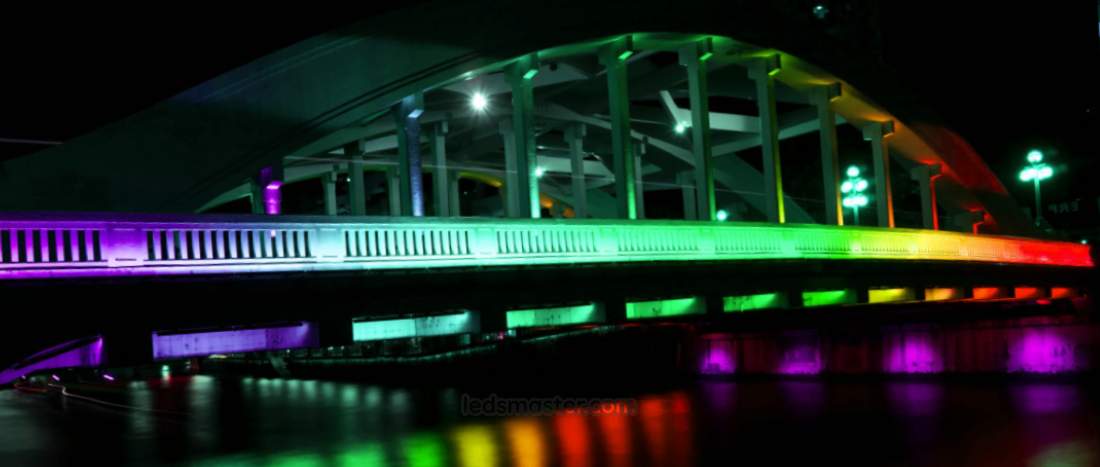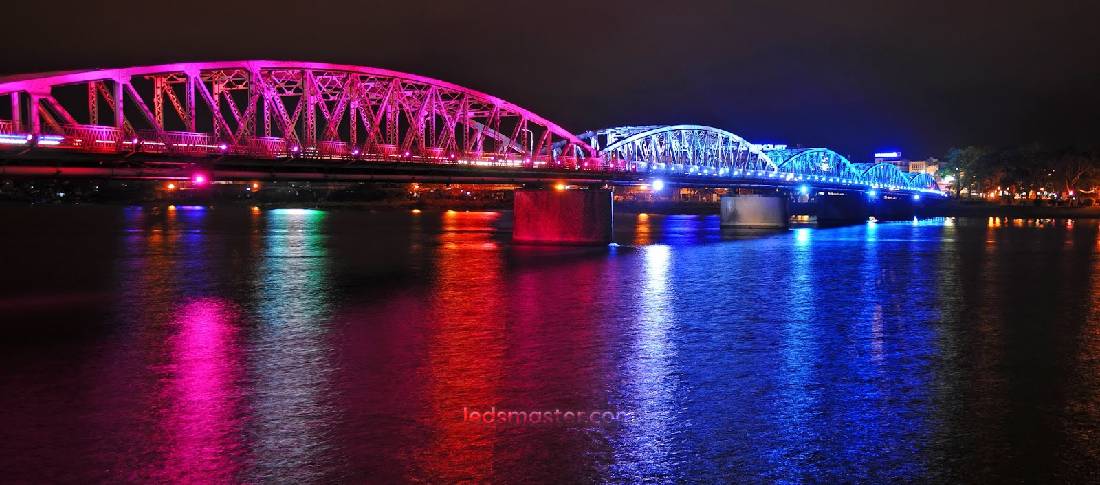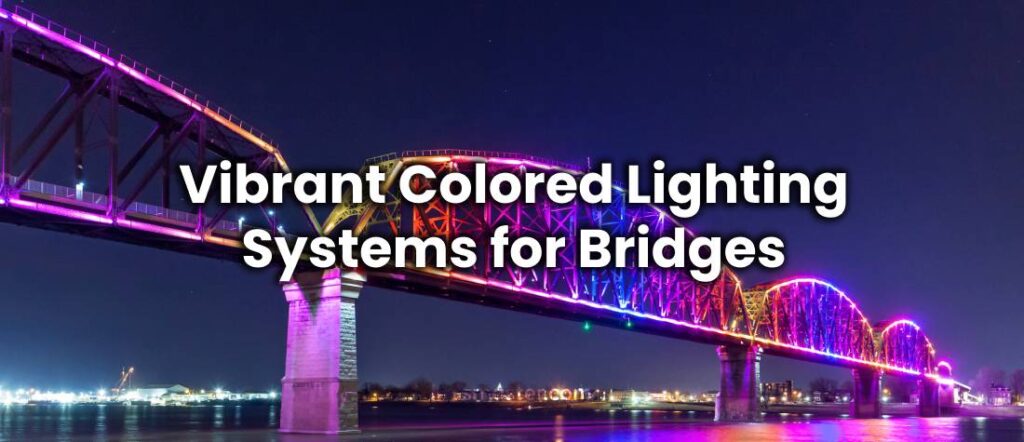In recent years, the role of bridges has expanded beyond mere functionality to become prominent landmarks and aesthetic features in urban landscapes. Vibrant colored lighting systems are at the forefront of this transformation, offering not only enhanced visibility but also artistic and emotional impact. The advent of LED technology has revolutionized bridge lighting, enabling dynamic and color-rich displays that can transform a bridge into a vibrant spectacle. This article explores the application of vibrant colored lighting systems for bridges, with a focus on LED lights, control systems, design considerations, and the myriad benefits they offer.
Table of Contents
ToggleThe Role of Vibrant Colored Lighting Systems
Vibrant colored lighting systems have become an integral part of modern bridge design, serving multiple purposes. Traditionally, bridge lighting was primarily functional, aimed at ensuring safety and visibility during nighttime. Today, however, lighting has evolved into a crucial element of a bridge’s identity and its integration into the surrounding urban environment. Colored lighting systems can highlight a bridge’s architectural features, create visual impact, and even convey messages or themes through dynamic color changes. This transformation is largely driven by advancements in LED technology, which allows for precise control over color, intensity, and patterns.

Dynamic Color Control
The ability to manipulate color and light intensity with precision is one of the most compelling advantages of LED technology in bridge lighting. Sophisticated control systems offer extensive capabilities that enable designers to craft visually stunning and dynamic lighting displays. This section explores the various aspects of dynamic color control, including the technology behind it, its applications, and its benefits.
DMX Controllers
At the heart of dynamic color control are DMX (Digital Multiplex) controllers. DMX technology, originally developed for controlling stage lighting, has become a cornerstone of modern architectural lighting. These controllers manage multiple channels of lighting equipment, allowing for the precise control of various parameters such as color, intensity, and timing. With DMX controllers, lighting designers can create intricate sequences and effects by programming specific lighting cues that change over time.
DMX controllers can handle hundreds of individual channels, each controlling different aspects of the lighting system. This capability enables the creation of complex and synchronized displays where multiple lights work together to produce cohesive visual effects. For example, a bridge can be illuminated with a cascading color effect that transitions smoothly from one hue to another, or a color-changing pattern that pulses in sync with music.
Wireless and Remote Control
In addition to traditional wired DMX systems, modern lighting setups often incorporate wireless and remote control options. These advancements provide greater flexibility in managing lighting systems from a distance. Wireless DMX systems eliminate the need for extensive cabling, making installation simpler and more aesthetically pleasing. Remote control capabilities, including smartphone apps and web interfaces, allow for real-time adjustments and programming changes, making it easier to respond to events or conditions as they arise.
Adjustable Color Temperature
LEDs offer the unique ability to adjust color temperature, which refers to the warmth or coolness of the light. By modifying color temperature, lighting designers can create different atmospheres and visual effects. For example, cooler color temperatures (measured in Kelvins) can produce a crisp, white light that enhances visibility and gives a modern look, while warmer temperatures can create a softer, more inviting ambiance.
On bridges, adjustable color temperature can be used to reflect different times of day or seasonal changes. For instance, a bridge could feature a warm, golden light during autumn to complement seasonal events or a cooler, bluish light during winter to evoke a crisp, wintry feeling.
Variable Intensity Control
Variable intensity control allows for the adjustment of light brightness to suit various needs and contexts. With LED systems, intensity can be finely tuned to create dramatic effects or subtle highlights. This capability is particularly useful for creating lighting effects that need to be visible from a distance while avoiding excessive glare for drivers and pedestrians.
Bridges can benefit from variable intensity control by featuring lighting that adapts to different conditions. For example, intensity can be increased during special events or reduced during off-peak hours to conserve energy. Additionally, variable intensity can enhance the visual impact of color changes by adjusting brightness levels in conjunction with color transitions.

Design Considerations for Vibrant Colored Bridge Lighting
Architectural Integration
When designing a vibrant colored lighting system for a bridge, it is crucial to consider the bridge’s architecture and its surroundings. The lighting design should enhance the bridge’s aesthetic qualities without overwhelming its structural features. For example, a historic bridge may require a more subtle and elegant lighting scheme, while a modern bridge could benefit from bold, dynamic colors that highlight its contemporary design.
The placement of lights is also a key consideration. Lights should be positioned to minimize glare for drivers while maximizing the visual impact from various viewpoints. It is essential to balance lighting intensity and color to ensure that the bridge is both striking and safe.
Environmental and Safety Factors
Environmental considerations are paramount when designing bridge lighting systems. Bridges are exposed to various weather conditions, including rain, snow, and extreme temperatures. Therefore, lighting fixtures must be weather-resistant and capable of withstanding harsh environmental conditions. LEDs are particularly well-suited for this purpose due to their durability and resistance to temperature fluctuations.
Safety is another critical factor. The lighting system should not only illuminate the bridge effectively but also avoid causing distractions or glare for drivers and pedestrians. The integration of color-changing effects should be done thoughtfully to ensure that they enhance rather than detract from the bridge’s visibility and safety.
Control Systems and Programmability
Modern bridge lighting systems rely on advanced control systems to manage and coordinate the various aspects of the lighting design. These systems enable the creation of intricate lighting effects and color transitions, which can be programmed to change according to time, events, or special occasions. The use of wireless control systems and programmable logic controllers (PLCs) allows for remote management and real-time adjustments, providing flexibility and ease of operation.
Installation
Planning and Design
Before installation begins, thorough planning is essential. This includes conducting a detailed assessment of the bridge’s structure, surrounding environment, and desired lighting effects. The design phase should involve collaboration between lighting designers, engineers, and local authorities to address both aesthetic goals and practical considerations. Key factors such as light placement, color schemes, and control systems need to be meticulously planned to achieve the desired visual impact while maintaining safety and functionality.
Choosing the Right Fixtures
Selecting the appropriate lighting fixtures is crucial. LED technology is typically preferred for its energy efficiency, durability, and flexibility in color control. When choosing fixtures, consider factors such as weather resistance, mounting options, and compatibility with control systems. Fixtures should be robust enough to withstand environmental conditions, including rain, snow, and temperature fluctuations.
Electrical Considerations
Proper electrical installation is vital for the safe and effective operation of the lighting system. This involves running electrical wiring, installing power supplies, and ensuring that all connections are secure and compliant with local codes. It’s important to include surge protection and circuit breakers to safeguard the system against electrical faults and power surges.
Control Systems Setup
Setting up control systems, such as DMX controllers and wireless systems, is a key aspect of installation. These systems need to be configured to manage the lighting fixtures and create dynamic effects. For wired systems, ensure that all connections are properly made and tested. For wireless systems, perform range and signal strength tests to confirm reliable communication between the controllers and fixtures.
Testing and Calibration
Once installation is complete, a thorough testing and calibration process is necessary. This involves checking each fixture to ensure it is functioning correctly and making any necessary adjustments to the color, intensity, and patterns. Testing should also include verifying that the control systems operate as intended and that all safety features are in place.
Maintenance
Routine Inspections
Regular inspections are crucial for identifying and addressing potential issues before they become significant problems. Scheduled checks should include examining the physical condition of fixtures, ensuring there is no damage or corrosion, and verifying that electrical connections remain secure. Maintenance schedules should be designed based on the local climate and environmental conditions.
Cleaning and Upkeep
Cleaning fixtures is an important part of maintenance. Dust, dirt, and debris can accumulate on the lenses and housings, affecting the quality of light output. Use appropriate cleaning methods and materials to avoid damaging the fixtures. For outdoor installations, ensure that any protective coatings or treatments are maintained to enhance durability.
System Updates and Calibration
Periodically updating and recalibrating control systems helps maintain optimal performance. This may involve updating software or firmware, reprogramming sequences, and adjusting settings based on changes in environmental conditions or new design requirements. Regular updates also ensure compatibility with any new technologies or integration features.
Troubleshooting and Repairs
Addressing issues promptly is key to minimizing downtime. Troubleshooting involves diagnosing and resolving problems such as flickering lights, color inconsistencies, or control system malfunctions. Keeping spare parts on hand and having a well-trained maintenance team can expedite repairs and reduce disruption to the lighting system.
Monitoring and Data Collection
Advanced systems often include monitoring features that provide real-time data on performance and energy usage. Utilizing these features can help identify inefficiencies, track system performance, and inform maintenance strategies. Data collected from monitoring can also guide future upgrades or improvements to the lighting system.
Benefits of Vibrant Colored Lighting Systems
Aesthetic Appeal
A well-designed lighting scheme can elevate a bridge from a mere infrastructural element to a landmark of urban beauty. By employing a palette of colors and dynamic lighting effects, bridges can become striking visual statements that capture the essence of their surroundings. Enhanced by carefully chosen hues and illuminating patterns, the bridge’s architectural features can be highlighted and celebrated, transforming it into a focal point that attracts attention and admiration. This aesthetic enhancement not only beautifies the urban environment but also creates a memorable visual impact, making the bridge a celebrated feature of the city’s landscape.
Community Engagement and Identity
By incorporating colors that reflect local culture, holidays, or events, a bridge can become a symbol of community pride and connection. Special lighting displays for festivals, national holidays, or charitable causes can foster a sense of belonging and enhance the cultural significance of the bridge.
Economic and Environmental Benefits
From an economic perspective, LED lighting systems offer significant cost savings due to their energy efficiency and long lifespan. Reduced energy consumption translates into lower operating costs, while the durability of LEDs reduces maintenance and replacement expenses. Additionally, the environmental benefits of LEDs include a reduction in carbon footprint and a decrease in light pollution, as LED systems can be designed to focus light where it is needed and minimize stray light.
Integration with Smart City Technologies
IoT Integration
The integration of Internet of Things (IoT) technology into bridge lighting systems represents a significant advancement in smart city infrastructure. IoT-enabled lighting systems leverage sensors and data analytics to create more responsive and adaptive lighting solutions. For example, IoT sensors can monitor environmental conditions, such as weather and traffic patterns, and adjust lighting accordingly. This capability ensures that lighting levels are optimized for visibility and safety while minimizing energy consumption.
IoT integration also allows for remote monitoring and control of lighting systems. City officials can manage and adjust bridge lighting from a central control center or even via mobile devices. This flexibility facilitates real-time updates and troubleshooting, enhancing the system’s efficiency and reliability. Additionally, IoT technology can gather data on light usage and performance, providing valuable insights that can inform future upgrades and maintenance strategies.
Energy Management Systems
Advanced energy management systems use real-time data to optimize energy consumption, ensuring that lights are only as bright as necessary and are activated only when needed. For example, energy management systems can adjust lighting intensity based on traffic volume, dimming the lights during low-traffic periods and increasing brightness during peak times or adverse weather conditions.
Moreover, incorporating renewable energy sources, such as solar panels, into bridge lighting systems can further enhance sustainability. Smart energy management systems can integrate solar power with grid electricity, reducing reliance on non-renewable sources and decreasing overall energy costs. The ability to monitor and control energy use in real time helps cities achieve their sustainability goals while maintaining effective and visually appealing lighting.
Conclusion
Vibrant colored lighting systems have redefined the role of bridges from simple passageways to dynamic urban landmarks. The integration of advanced LED technology and sophisticated control systems has enabled bridges to not only enhance visibility but also create striking visual displays that contribute to the cultural and aesthetic fabric of urban environments. By leveraging precise color control, wireless capabilities, and smart city technologies, these lighting systems offer both practical and artistic benefits. Their ability to adapt to various conditions and display dynamic effects makes them a powerful tool in bridge design, merging functionality with creativity to transform bridges into celebrated features of the cityscape.

